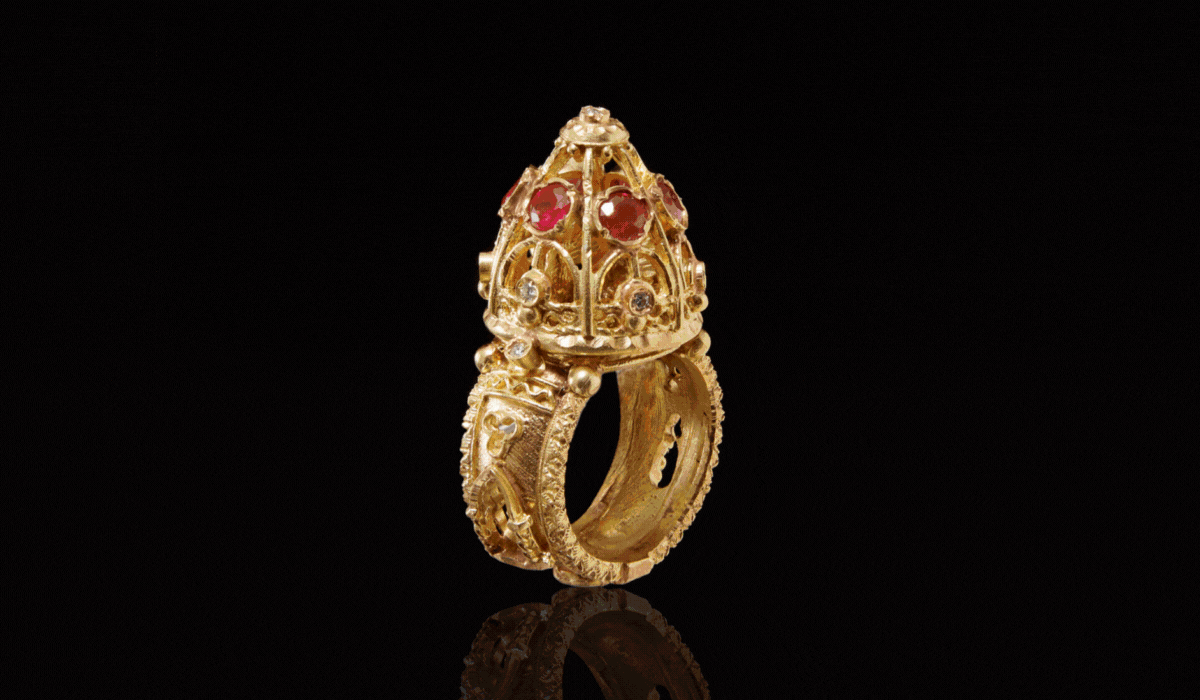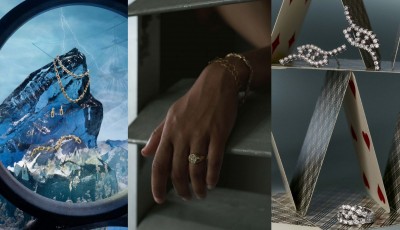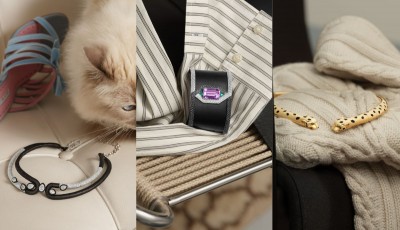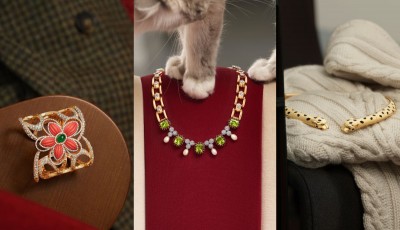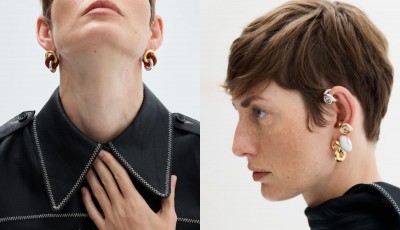The Crazy Thinking of Jewelry
Some jewels are created to decorate, embellish, celebrate a common idea of beauty. Others, to subvert, shock, cross the boundaries of the predictable. In the minds of those who dare the unthinkable: Alessandro Dari, Lydia Courteille e Alessio Boschi
Folly is an essential and beneficial element of humanity, according to Erasmus of Rotterdam who, in his famous “In Praise of Folly,” wrote: «The best ideas do not come from reason, but from a lucid, visionary madness.» Far from wanting to venture into intricate philosophical issues, we have borrowed this statement to explore “crazy thinking,” taken in its most positive meaning as the inspiring principle behind jewelry that crosses the boundaries of rationality. A powerful genetic prerogative of a few creative artists polarized toward daring, complex, out-of-the-box exploration. Their courage defies technical limits and market rules to generate unthinkable, yet possible aesthetics, the result of unpredictable ideas, shapes and materials. Alessandro Dari, Lydia Courteille and Alessio Boschi are among them. «Experimental jewelry may be the prelude to a new life that no one knows yet,» says Dari, master in goldsmith arts, sculptor and musician, one of Italy's most visionary artist/designers, who pushes his work to emotional and conceptual depths. In his opinion, folly is a gift: «The third eye, the one that sees and feels everything in a form very close to a truth of the moment, but is historical in memories. This is where emotions are born, this is where I work with shapes.» His creations are living structures, organisms in which matter becomes mechanism, where metal comes alive and expresses the unspeakable. More than looking for wonder in itself, the intention is to give form to what is intangible. «I have made jewelry that is bold in shape and size. It brought real machinery to life that can tell a story by moving and interacting in the resulting shapes.» An example of utopian engineering. As in the large chalice in Fiesole Cathedral, a sculpture that subverts the logic of resurrection. «Christ's tomb was closed, He was outside, protecting the lives of parentless children.» A theological and symbolic reversal, a game of inversions that forces one to look with new eyes.
While in Dari’s opinion, folly gives access to a higher dimension, according to Lydia Courteille, it is a form of provocation, born from an irreverent, cultured and refined attitude. For more than twenty years, the French designer’s language has taught us that anything can happen. «I create what I would like to have in jewelry. I love to push the boundaries to introduce unusual pieces and subjects. My creations are the syncretism of my brain.» Syncretism that generates pieces in which eras, iconographies and cultures meet, creating parallel universes.
According to Alessio Boschi, another prolific exponent of imaginative jewelry, «Each piece of jewelry is a challenge between the material and the idea, a way to express something new. Folly is the tool that allows us to go beyond the boundaries of convention.» Boschi experiences creation as an act of transformation, working with innovative and unconventional materials that are often difficult to handle. The designer overturns the rules of tradition, even though he respects them, in authentic works of visual and sensory communication. A “way of doing” that, by mixing experimentation and rigorous attention to technique, generates jewels brimming with stories that ignite fertile flashes of reflection.
But can out-of-the-box thinking deal with reality? Sometimes the answer is not obvious. «When I created my “Me Too” ring - with open lips and street signs inside - I thought I would develop an entire collection,» Courteille says. «I only produced that one piece, as it was never adequately promoted in the media.» A piece of jewelry can sometimes express too much, be disturbing, or rejected. Yet, “crazy thinking” always finds a way, even when unexpected obstacles need to be overcome. As in her Erotic collection, where she faced a paradox between creative freedom and personal censorship: «The sculptor was hesitant to sculpt erotic scenes inspired by the Kamasutra due to personal beliefs. In the end, I found someone else and was able to produce the ring that earned me many customers.»
The supremacy of an untamed freedom also affects Boschi's work. «In developing my ideas, I have encountered obstacles at every stage: from stone setting and cutting, from manufacturing to mechanisms and CAD designers. But I have looked for excellence in each technique, because I believe that everything is possible in jewelry; it's just a matter of time and money. I have waited months for creations, giving even my late-night hours to work with my goldsmiths, making sure they were rightly compensated, despite the sacrifices. In the end, we have managed to create truly admirable pieces.» The balance between the willingness to challenge codes and the need to remain understandable on the market is extremely delicate. A jewel may dare, but how willing is the audience to accept it? Dari and Courteille know that the public is always one step behind the vision, but they also know that uniqueness finds the results it deserves. «My clients are often in search of bold jewelry that gives them emotions,» says Dari. And Courteille confirms, «Some of my creations propose controversial themes, but I think my clients appreciate provocation. We are on the border of art, and art needs provocation.» While Boschi says, «My clients today have become accustomed to being surprised. After getting to know me, they expect to discover the mechanisms and secrets hidden behind my creations.» Hence the quest for not being repetitive, for surprising again and again, becomes the driver of a creative process that evolves over the years and with experience. «The more honest and pure one is, the more the universe will lead us to meet customers who share our same values,» Boschi asserts.
But how far can the ideas of those who dare to think the unthinkable go? Goldsmith art could experience metaphysics by following the mind of Dari, whose secret dream is «to create forms of pure energy without the use of matter. Only perception can feel them in a sacred, indescribable geometry: it is the look of your eyes 100 years from now, living in the Middle Ages.» Fine jewelry could expand limitlessly by pandering to Courteille's will: «My dream is a collection full of blue diamonds! But given the size of my pieces, that can't happen yet.» And, crossing into a surreal dimension with Alessio Boschi: «For at least 40 years I have been making surreal designs, set among Hieronymus Bosch-like stills and acanthus and thistles leaves, among fanciful botanies, chiaroscuro swirls and precious stones with particular cuts. Perhaps they come from my brain or from another energy and dimension. It is my wish to create some of them, sooner or later.»
While in Dari’s opinion, folly gives access to a higher dimension, according to Lydia Courteille, it is a form of provocation, born from an irreverent, cultured and refined attitude. For more than twenty years, the French designer’s language has taught us that anything can happen. «I create what I would like to have in jewelry. I love to push the boundaries to introduce unusual pieces and subjects. My creations are the syncretism of my brain.» Syncretism that generates pieces in which eras, iconographies and cultures meet, creating parallel universes.
According to Alessio Boschi, another prolific exponent of imaginative jewelry, «Each piece of jewelry is a challenge between the material and the idea, a way to express something new. Folly is the tool that allows us to go beyond the boundaries of convention.» Boschi experiences creation as an act of transformation, working with innovative and unconventional materials that are often difficult to handle. The designer overturns the rules of tradition, even though he respects them, in authentic works of visual and sensory communication. A “way of doing” that, by mixing experimentation and rigorous attention to technique, generates jewels brimming with stories that ignite fertile flashes of reflection.
But can out-of-the-box thinking deal with reality? Sometimes the answer is not obvious. «When I created my “Me Too” ring - with open lips and street signs inside - I thought I would develop an entire collection,» Courteille says. «I only produced that one piece, as it was never adequately promoted in the media.» A piece of jewelry can sometimes express too much, be disturbing, or rejected. Yet, “crazy thinking” always finds a way, even when unexpected obstacles need to be overcome. As in her Erotic collection, where she faced a paradox between creative freedom and personal censorship: «The sculptor was hesitant to sculpt erotic scenes inspired by the Kamasutra due to personal beliefs. In the end, I found someone else and was able to produce the ring that earned me many customers.»
The supremacy of an untamed freedom also affects Boschi's work. «In developing my ideas, I have encountered obstacles at every stage: from stone setting and cutting, from manufacturing to mechanisms and CAD designers. But I have looked for excellence in each technique, because I believe that everything is possible in jewelry; it's just a matter of time and money. I have waited months for creations, giving even my late-night hours to work with my goldsmiths, making sure they were rightly compensated, despite the sacrifices. In the end, we have managed to create truly admirable pieces.» The balance between the willingness to challenge codes and the need to remain understandable on the market is extremely delicate. A jewel may dare, but how willing is the audience to accept it? Dari and Courteille know that the public is always one step behind the vision, but they also know that uniqueness finds the results it deserves. «My clients are often in search of bold jewelry that gives them emotions,» says Dari. And Courteille confirms, «Some of my creations propose controversial themes, but I think my clients appreciate provocation. We are on the border of art, and art needs provocation.» While Boschi says, «My clients today have become accustomed to being surprised. After getting to know me, they expect to discover the mechanisms and secrets hidden behind my creations.» Hence the quest for not being repetitive, for surprising again and again, becomes the driver of a creative process that evolves over the years and with experience. «The more honest and pure one is, the more the universe will lead us to meet customers who share our same values,» Boschi asserts.
But how far can the ideas of those who dare to think the unthinkable go? Goldsmith art could experience metaphysics by following the mind of Dari, whose secret dream is «to create forms of pure energy without the use of matter. Only perception can feel them in a sacred, indescribable geometry: it is the look of your eyes 100 years from now, living in the Middle Ages.» Fine jewelry could expand limitlessly by pandering to Courteille's will: «My dream is a collection full of blue diamonds! But given the size of my pieces, that can't happen yet.» And, crossing into a surreal dimension with Alessio Boschi: «For at least 40 years I have been making surreal designs, set among Hieronymus Bosch-like stills and acanthus and thistles leaves, among fanciful botanies, chiaroscuro swirls and precious stones with particular cuts. Perhaps they come from my brain or from another energy and dimension. It is my wish to create some of them, sooner or later.»


